Moyo Onibuje, 43, an eloquent man with a college degree and faint British accent, said he followed a love-interest from the United Kingdom to the United States seven years ago.
He made the wrong friends, was robbed of everything he owned, and battled an alcohol and cocaine addiction. Today he is homeless, and he camps out with his girlfriend on North Capitol Street.
“I was what you would call a man with no name,” Onibuje said. “I had nothing to prove who I was.”
But for six months now he has been with Street Sense, a paper that gives him an outlet for his writing and puts money in his pocket.
Street Sense is a bi-weekly newspaper run by the homeless that serves to both inform the public about issues related to homelessness and provide its poor vendors some immediate income. Since its establishment in 2003, circulation has grown by 120 percent, said Laura Thompson Osuri, executive director and co-founder of the paper.
Since 2004, their operating expenses have grown nearly 1,000 percent, and they still manage to generate a sizable profit. Osuri said they recently approved a budget for nearly $250,000 in 2008.
“The word just spread,” Osuri said. “The stories are interesting and the quality of vendors has improved. That helps the sales.”
Vendors buy the paper from the organization for 25 cents and sell it for a dollar, which typically provides them with $40 to $70 in cash per day. Over time, this has allowed one third of the paper’s vendors to start part time jobs or find a home of their own, according to their 2006 annual report.
Most of the vendors are male, 51 to 60 years old, and natives of the District. Nearly half had some college experience, but have been homeless for at least two years and often sleep in shelters or on the street.
The work empowers the homeless to take things into their own hands, said vendor Martin Walker, 35, a D.C. native. “People show me a lot of respect when I’m selling Street Sense. They see that I am trying to get ahead and make a difference.”
Sixty active vendors help circulate 10,000 to 11,000 copies of this “homeless-centric” paper, which features both editorials written by the homeless and news related to their issues written by volunteers.
“I don’t get paid for writing,” said Eric Sheptock, 39, one of the paper’s homeless contributors, pointing to his most recent article that draws from his testimony at the D.C. Council’s Committee on Housing and Urban Affairs. “But I get to publish the issues I am passionate about.”
Sheptock said health care is especially important to him. “With all our medical advances, poverty should not be a cause of death,” he said.
“The mission of Street Sense is to give a voice to the homeless,” said Osuri, herself a former journalist, who originally co-founded the paper as a project of the National Coalition for the Homeless.
“To start, we hit up friends and family for donations,” Osuri said. They look for vendors in soup kitchens, shelters, or public parks, and provide them with brief, on-site training. In 2003, they printed their first 5,000 copies armed with eight vendors and $1,500 in donations.
“My husband is in finance and he urged me to make a three-year budget plan,” said Osuri. “But I said ‘I don’t know where we’ll be in a month.'”
Nearly half of the newspaper’s funds stem from individual donations and a about a quarter from various grants. The remainder is split between paper sales and advertising, largely from non-profit organizations.
The Street Sense office is now equipped with multiple computers, three paid staff, interns and dozens of volunteers who also attempt to connect their vendors with housing and job providers to allow them to find their way out of homelessness.
Street Sense changed Onibuje’s life. Now, he said, all he needs is a computer so he can improve his writing.
“I believe in the issues Street Sense stands for, bringing information to the people about the causes and effects of homelessness,” Onibuje said. “That’s just my life right now but things are looking better for me.”






